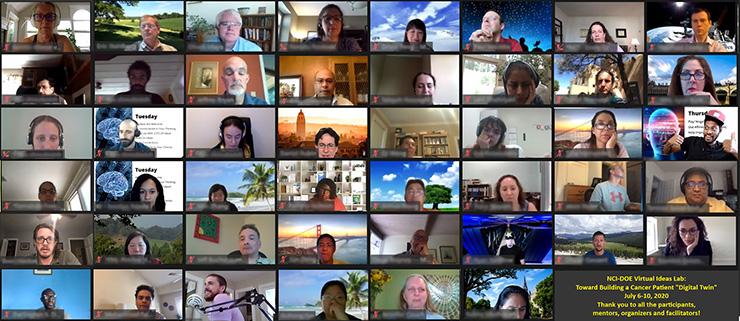Used successfully in several industries, digital twins have the potential to forge a path toward advances in cancer care and research. By melding computational science with the field of medicine, scientists aim to use digital twins to ultimately predict the effect of new therapies on cancer patients by using computer models without harming actual humans. Frederick National Laboratory (FNL) is a lead organization in the strategic interagency collaboration between the National Cancer Institute (NCI) and the U.S. Department of Energy (DOE) and has been instrumental in the development of innovative technologies for creating a cancer patient digital twin.
A digital twin is a virtual model used to make predictions and run simulations without disrupting or harming the real-world object. Digital twins are used in aerospace engineering, automobile design, climate studies, and many other fields.
In health care, a digital twin is a virtual substitute of the human body that allows scientists and physicians to examine possible outcomes of various treatments. In the future, a cancer patient’s digital twin (a.k.a., avatar or virtual patient) could be used for personalized medicine; cancer research, preclinical development, and clinical trials; diagnosis; and simulations of treatment.
The Future of Digital Twins in Cancer Care
“We are at the cusp of transformative research,” said Eric Stahlberg, Ph.D., director of FNL’s Biomedical Informatics and Data Science Directorate and a program co-lead of the NCI–DOE collaboration.
Even as some aspects of cancer patient digital twins are already being explored, the integration of all capabilities remains a grand challenge for the convergence of advanced computing technologies and oncology. A cancer patient’s digital twin would be the ideal resource for personalized treatment. Doctors could use the data to better select the most effective treatment and help patients weigh their treatment choices against their personal priorities and constraints. This technology could serve as a powerful tool to help doctors and patients communicate better and facilitate informed patient choice and shared decision-making.
From a policy perspective, a digital twin could identify high-risk populations and allow policymakers to evaluate different screening practices and guidelines.
“To achieve the reality of a digital twin for cancer care, scientists and clinicians will need to bridge across many disciplines, including cancer, biology, and computing, and envision how a human ‘digital twin’ could provide transformative insights and predictions about multiple, complex interactions that clinicians need to improve treatment for patients,” Stahlberg said.
In July 2020, the NCI–DOE collaboration held a five-day virtual ideas lab, “Toward Building a Cancer Patient ‘Digital Twin.’” The event brought together a diverse group of researchers to form new collaborations and create innovative research projects that would advance the development of a cancer patient digital twin. In late 2020, five project teams were selected to receive seed funding—made possible by DOE and NCI—through FNL. Three of those teams were also invited to apply for additional DOE funding.
Each project focuses on a digital twin research area that, within the next two to three years, seeks to advance the development of a model of an individual cancer patient. These projects have the potential to lead to disease- and intervention-specific models and simulations by using mathematical, active learning, and ensemble model approaches.
“The scientific teams selected will bring us one step closer to tackling a risky but exciting new area of predictive oncology research,” said Emily Greenspan, Ph.D., program director at NCI’s Center for Biomedical Informatics and Information Technology. “The seed funding will enable them to use their creativity and outside-the-box thinking to bring us closer to realizing digital twins for cancer care.”
The digital twin ideas lab was published by invitation in the CitizenScience.gov project catalog as part of the 2019–2020 Office of Science and Technology Policy Crowdsourcing and Citizen Science Reporting data call, a multi-agency report from the White House.
Since 2016, NCI and DOE have been collaborating on the Joint Design of Advanced Computing Solutions for Cancer (JDACS4C) program to simultaneously accelerate advances in predictive oncology and scientific computing. FNL has helped lead the development of innovative technology to advance the creation of a cancer patient digital twin. The lab also works with NCI and DOE to provide seed funding for cancer patient digital twin research projects.
For more information, visit the Envisioning Computational Innovations for Cancer Challenges hub site.
Petrina Hollingsworth is the JDACS4C community engagement manager. She joined Frederick National Laboratory’s Biomedical Informatics and Data Science Directorate in March 2020 to help raise the profile of JDACS4C and NCI–DOE collaborations across the broader cancer research community; generate interest in opportunities to participate in multidisciplinary research; and promote the availability of developed NCI–DOE and JDACS4C software, data, and computational models.
Lynn Borkon provides leadership for development of collaborative strategic and data science initiatives, focusing on engagement strategies to develop cross-organizational and trans-disciplinary communities in predictive oncology, artificial intelligence, and cancer data science.
FNL’s Biomedical Informatics and Data Science Directorate provides the advanced services, tools, and capabilities to researchers nationwide to accelerate the translation of biomedical data to scientific discoveries, insights, medical treatments, diagnostic approaches, and prevention tools for cancer, AIDS, and emerging health threats.


